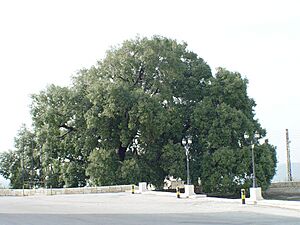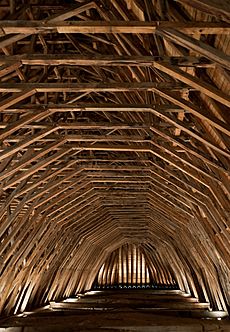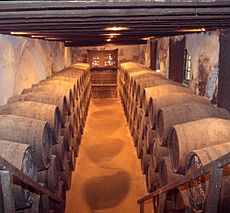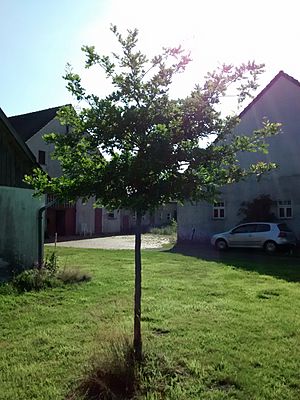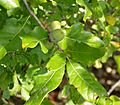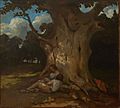Oak facts for kids
Quick facts for kids Oaks |
|
|---|---|
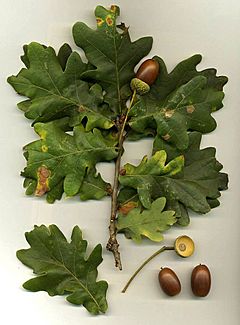 |
|
| Foliage and acorns of Quercus robur | |
| Scientific classification | |
| Kingdom: | |
| Phylum: | |
| Class: | |
| Order: | |
| Family: | |
| Genus: |
Quercus
|
An oak tree is a type of tree or shrub. It belongs to a group of plants called Quercus. There are about 600 different kinds, or species, of oak trees. Sometimes, trees that are related to oaks, like Lithocarpus, are also called oaks.
Oak trees grow naturally in the Northern Hemisphere. You can find them in many places, from cool areas to tropical regions in Asia and the Americas. North America has the most oak species, with about 90 kinds in the United States. Mexico has even more, with 160 species, and 109 of these are found only there. China is another place with many oaks, having about 100 species.
Oak leaves usually grow in a spiral pattern. Many species have leaves with rounded edges, while others have jagged edges or smooth ones. Some oak trees keep their dead leaves on their branches until spring. In spring, a single oak tree grows both male flowers (called catkins) and small female flowers. The fruit of an oak tree is a nut called an acorn. Each acorn has one seed, and it can take 6 to 18 months to grow fully, depending on the oak species. Some oaks, known as "live oaks," stay green all year round. They are not a special group of oaks, but just a type that keeps its leaves.
Oak trees are a kind of hardwood forest tree. They are known for being a "climax vegetation" in the temperate zone of the Northern hemisphere. This means that if humans didn't interfere, oaks would be the main type of tree in these areas. A long time ago, much of England was covered in oak forests. Many of these forests were cut down in the 18th century to build ships for the Royal Navy.
Oak wood is very strong and hard. In the past, a lot of furniture was made from oak. Today, oak wood is harder to find and more expensive than softer woods like pine. Oak trees can live for a very long time, sometimes up to 1000 years!
Contents
Animals Living in Oak Trees
A grown-up oak tree can be as tall as a 10-story building, about 100 feet (30 meters) high. It provides a home for more animals than almost any other European tree. Scientists have found 30 different bird species, 45 kinds of bugs, and over 200 types of moths living on oaks.
Beetles dig tunnels under the bark, and some even drill into the wood. Many caterpillars love to eat oak leaves. You might also see strange bumps on the underside of oak leaves. These are called insect galls. They are caused by tiny animals like Midges, moths, and small wasps that lay their eggs in the leaves or leaf buds. The leaf then grows a protective bump around the eggs. Inside the gall, the larvae (baby insects) grow. The leaf falls off, but the larvae might not come out until the next spring. Small galls usually have one larva, but bigger ones can have as many as 30!
Acorns: The Oak's Seeds
Main article:Acorn
Oak trees produce acorns once a year, and they become ripe in autumn. Oak trees usually start making acorns when they are about 20 years old. A mature oak tree can produce as many as 90,000 acorns in a single year! Over its lifetime, one oak tree can produce millions of acorns.
How Oak Wood is Used
Oak wood is very dense, which makes it incredibly strong and hard. It's also very good at resisting insects and fungi because it contains a lot of tannin. Oak wood also has beautiful patterns in its grain, especially when it's cut in a special way called "quartersawn."
Oak planks were used on high-status Viking longships in the 9th and 10th centuries. Since the Middle Ages, wide, quartersawn oak boards have been highly valued for decorating the inside of important buildings. For example, the debating chamber of the House of Commons in London uses oak paneling. Oak wood was also the main material for building ships, especially naval warships, in Europe until the 19th century. It was also widely used for timber-framed buildings. Today, oak wood is still commonly used for furniture making, flooring, and veneers.
Barrels used to age wines, sherry, and spirits like brandy, Irish whiskey, Scotch whisky, and Bourbon whiskey are made from European and American oak. The type and style of oak used can add many different flavors to wine. Oak barrels, which are sometimes burned on the inside before use, give these drinks a desirable oaky, vanillin flavor, and contribute to their color and smell.
Japanese oak is used to make professional drums by the company Yamaha Drums. The high density of oak gives the drums a brighter and louder sound compared to drums made from other woods like maple and birch. In some parts of India, local people use oak wood for farm tools, besides using it for fuel and timber. Oak leaves are also used as food for livestock during times when other food is scarce.
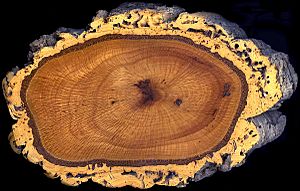
The bark of the cork oak is used to make wine stoppers (corks). This type of oak grows around the Mediterranean Sea. Portugal, Spain, Algeria, and Morocco produce most of the world's cork.
In North America, the Northern red oak is a very popular type of red oak for lumber. However, it's not great for outdoor use unless it's treated, because it has tiny open tubes that allow water and fungus to get in. White oaks, like the Quercus alba, have a closed cell structure that prevents them from absorbing water easily, making them good for things like wine barrels. In Europe, the wood from the pedunculate oak and sessile oak makes up most of the oak production.
The bark of the white oak is sometimes dried and used in medical preparations. Oak bark is also rich in tannin, which is used to make leather. Acorns can be used to make flour or roasted to make a coffee-like drink.
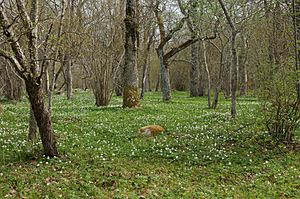
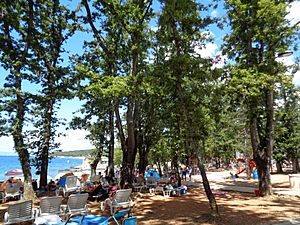
For centuries, oak galls were a key ingredient in iron gall ink, a type of ink used for writing manuscripts. In Korea, oak bark is used to make shingles for traditional roofs.
Related pages
Images for kids
-
A hybrid white oak, possibly Quercus stellata × Q. muhlenbergii
-
Grīdnieku ancient oak in Rumbas parish, Latvia, girth 8.27 m, 2015
-
The Big Oak, by Gustave Courbet (1843).
-
Tin Oak in Henryków Poland; the name refers to the steel fittings that fasten the damage to the tree.
See also
 In Spanish: Quercus para niños
In Spanish: Quercus para niños


